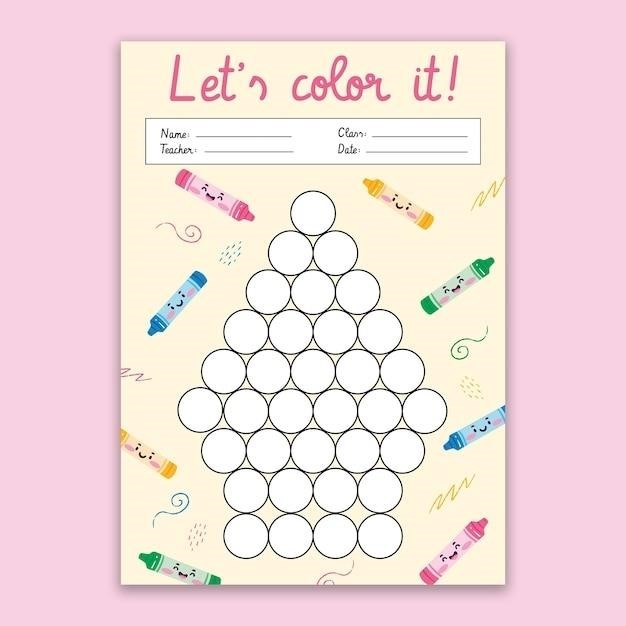Blank Hundreds Chart PDF⁚ A Comprehensive Guide
This guide explores the versatile applications of blank hundreds charts in PDF format․ Discover how these readily available resources facilitate number recognition, counting practice, and pattern identification for students of all ages․ Downloadable in various formats, they provide a foundational tool for enhancing mathematical understanding and fostering a love of learning․
Types of Hundreds Charts Available
The availability of hundreds charts in PDF format caters to diverse learning styles and educational needs․ Blank hundreds charts offer a foundational tool for students to practice writing numbers 1-100, fostering number recognition and sequencing skills․ These blank templates provide a flexible platform for various activities, from simple number writing to more complex pattern exploration․ Pre-filled hundreds charts serve as valuable reference tools, allowing students to visualize number patterns and relationships․ These charts can be used for identifying odd and even numbers, skip counting sequences, and recognizing numerical patterns․ Partially filled charts present an engaging challenge, requiring students to fill in missing numbers, strengthening problem-solving skills and solidifying number sense․ Variations include charts extending beyond 100, accommodating older students or more advanced concepts․ The diverse options ensure that a suitable hundreds chart is readily accessible for any classroom or individual learning environment․ The flexibility of the PDF format allows for easy printing, customization, and integration into diverse learning activities․ The versatility of these resources makes them invaluable tools for educators and parents alike, supporting effective mathematical instruction and skill development․
Blank Hundreds Charts for Number Writing Practice
Blank hundreds charts in PDF format are invaluable for developing fundamental number writing skills․ The structured grid provides a clear framework for students to practice writing numbers sequentially from 1 to 100, reinforcing number recognition and improving handwriting․ This repetitive practice strengthens fine motor skills and enhances number fluency․ The visual organization of the chart helps students understand the numerical sequence and identify patterns, such as the consistent increase of one unit in each successive number․ The blank format allows for personalized learning, enabling students to work at their own pace without the distraction of pre-filled numbers․ Teachers can easily adapt the charts for differentiated instruction, providing additional support or challenges as needed․ Furthermore, blank charts can be used in conjunction with other activities, such as number tracing or coloring exercises, to create a more engaging and multi-sensory learning experience․ The readily available PDF format makes it easy to create multiple copies for individual student use or classroom activities, ensuring ample practice opportunities for all learners․ The simple yet effective design of the blank hundreds chart makes it a versatile tool for reinforcing basic number writing and solidifying foundational mathematical concepts․
Filled Hundreds Charts for Reference and Pattern Recognition

Filled hundreds charts, readily available as PDFs, serve as exceptional tools for enhancing both number recognition and pattern identification․ The visual representation of the complete number sequence from 1 to 100 offers immediate reference for students, aiding in memorization and recall․ The organized grid format allows for easy identification of number relationships and patterns․ Students can readily observe the consistent increase of one unit in each successive number, reinforcing the concept of sequential order․ Furthermore, filled charts facilitate the exploration of more complex patterns, such as skip counting by twos, fives, or tens․ This visual exploration helps students develop a deeper understanding of number relationships and strengthens their number sense․ The color-coded versions often available in PDF format can enhance pattern recognition further, making it easier to identify specific sequences or groups of numbers․ The ability to readily print these charts from PDF files makes them a readily accessible resource for both classroom and home use, providing consistent reinforcement of number recognition and pattern identification skills․ These charts are particularly beneficial for visual learners, providing a concrete visual aid to support abstract number concepts․ Their use promotes a more active and engaging learning experience, moving beyond rote memorization to a more insightful understanding of number patterns․
Hundreds Charts with Missing Numbers for Problem-Solving
Hundreds charts with missing numbers present a dynamic approach to fostering problem-solving skills within a mathematical context․ These charts, easily accessible as downloadable PDFs, challenge students to actively engage with number sequences and patterns, moving beyond passive observation to active participation․ By filling in the missing numbers, students hone their number sense, reinforcing their understanding of sequential order and numerical relationships․ The varying levels of difficulty, from a few missing numbers to significantly more, allow for differentiation based on individual student needs and abilities․ This adaptable feature makes these charts suitable for a wide range of ages and skill levels, ensuring appropriate challenge and engagement․ The process of filling in the gaps encourages critical thinking and analytical skills as students must consider the surrounding numbers to deduce the missing values․ This active problem-solving strengthens their understanding of number placement within the larger framework of the hundreds chart․ These charts are also excellent tools for assessing student understanding, providing a clear indication of their grasp of number sequence and pattern recognition․ The readily available PDF format further enhances their practicality, allowing for easy printing and distribution, ensuring their suitability for both classroom and individual practice․

Utilizing Hundreds Charts in Educational Settings
Hundreds charts, readily available as printable PDFs, serve as invaluable tools within diverse educational settings․ Their adaptability caters to various learning styles and grade levels, making them a versatile resource for educators․ In kindergarten and elementary classrooms, these charts facilitate the foundational learning of number recognition and sequencing, assisting young learners in grasping the order and progression of numbers from 1 to 100․ The visual representation aids in understanding numerical patterns and relationships, paving the way for a stronger grasp of more advanced mathematical concepts․ Furthermore, hundreds charts can be utilized to introduce skip counting, reinforcing multiplication and division skills․ By visually highlighting multiples, students can readily identify patterns and develop a deeper understanding of these core mathematical operations․ The flexibility of the blank hundreds chart also allows for creative adaptations․ Teachers can incorporate them into engaging games and activities, transforming rote learning into interactive experiences․ For instance, missing number activities enhance problem-solving skills and critical thinking․ These adaptable charts can also be used for assessing individual student progress․ By observing a student’s ability to complete these charts accurately and efficiently, teachers can pinpoint areas needing further attention, facilitating targeted interventions and individualized learning strategies․ The ease of accessibility through readily available PDF files contributes to their practicality and widespread use in educational settings․
Hundreds Charts for Kindergarten and Elementary School
Blank hundreds charts in PDF format are invaluable resources for kindergarten and elementary school educators․ Their simple, grid-based design provides a visually engaging tool for young learners to grasp fundamental number concepts․ In kindergarten, these charts can be used to introduce number recognition and sequencing, helping children learn to identify and order numbers from one to one hundred․ The visual structure aids in understanding the relationship between numbers, fostering a strong foundation for future mathematical learning․ As students progress through elementary school, the hundreds chart’s versatility expands․ It becomes a tool for practicing skip counting, a crucial skill for developing multiplication and division skills․ The visual pattern recognition inherent in skip counting on the hundreds chart helps children internalize these foundational mathematical operations․ Furthermore, the blank nature of the chart allows for various engaging activities․ Teachers can create customized exercises, such as filling in missing numbers or highlighting specific number patterns, to cater to individual student needs and learning styles․ This flexibility makes the hundreds chart a highly adaptable tool for differentiated instruction․ The readily available PDF format ensures easy access and printing, making it a practical and cost-effective teaching resource for educators across diverse settings․ The combination of visual appeal, adaptability, and accessibility makes the blank hundreds chart an indispensable tool in early mathematics education․
Hundreds Charts for Skip Counting and Pattern Identification
Printable blank hundreds charts are exceptionally effective tools for teaching skip counting and pattern recognition․ The visual structure of the chart allows students to see numerical patterns emerge as they skip count by different intervals (2s, 5s, 10s, etc․)․ This visual reinforcement significantly aids in understanding the concept of multiplication and division, laying a robust foundation for these more advanced mathematical operations․ By coloring or highlighting the numbers as they skip count, children actively engage with the pattern, making the learning process more dynamic and memorable․ Moreover, the blank chart encourages independent exploration․ Students can create their own skip-counting sequences, experimenting with different intervals and discovering patterns at their own pace․ This self-directed learning fosters critical thinking and problem-solving skills․ Furthermore, the hundreds chart facilitates the identification of other number patterns, such as odd and even numbers, prime numbers, and square numbers․ The visual representation of these patterns clarifies their mathematical relationships, fostering a deeper understanding of number properties․ The readily available PDF format makes these charts easily accessible, allowing educators to integrate this engaging learning tool seamlessly into their lessons․ The blank hundreds chart thus serves as a versatile and effective resource for reinforcing crucial mathematical concepts, fostering pattern recognition, and promoting a deeper understanding of number relationships․
Downloadable Hundreds Charts in PDF, PNG, and JPG Formats
The accessibility of hundreds charts in various digital formats significantly enhances their usability․ The prevalent PDF format offers a versatile option for printing, ensuring high-quality output suitable for classroom use or individual practice․ Its compatibility across different devices and operating systems makes it a convenient choice for educators and parents alike․ Beyond PDF, the availability of PNG and JPG formats provides additional flexibility․ PNG files maintain image clarity even when zoomed in or resized, making them suitable for digital displays or online activities․ JPG files, known for their smaller file sizes, are ideal for quick sharing and integration into online educational platforms or presentations․ This multi-format availability caters to diverse learning environments and technological preferences․ Whether printed for hands-on activities, projected onto a whiteboard for class discussions, or incorporated into interactive digital exercises, the versatility of these formats ensures that the hundreds chart remains a readily adaptable and effective learning tool․ The ease of download and diverse file types contribute to the widespread use and accessibility of this fundamental educational resource, promoting inclusivity and effective learning for all students․
Creative Uses of Hundreds Charts in Math Games
Blank hundreds charts are surprisingly versatile tools for creating engaging math games․ Transform a simple chart into a “Battleship” style game where students call out coordinates to “hit” numbers․ Alternatively, create a “Number Hunt” where students search for specific numbers or number sequences, reinforcing number recognition and order․ For older students, incorporate addition or subtraction challenges⁚ students roll dice and add or subtract the result from a starting number, marking their progress on the chart․ This enhances understanding of number operations within a visual context․ Skip counting games are easily implemented; students color in multiples of a chosen number, highlighting patterns and reinforcing multiplication skills․ Missing number activities present further challenges, requiring students to deduce missing numbers within a sequence, bolstering problem-solving abilities․ The possibilities extend to incorporating color-coding for odd and even numbers, prime numbers, or other number properties․ These interactive games foster active learning, transforming potentially mundane practice into enjoyable challenges that solidify mathematical understanding․ The adaptability of the blank hundreds chart ensures that the learning process remains engaging and effective, catering to diverse learning styles and skill levels․
Leave a Reply
You must be logged in to post a comment.